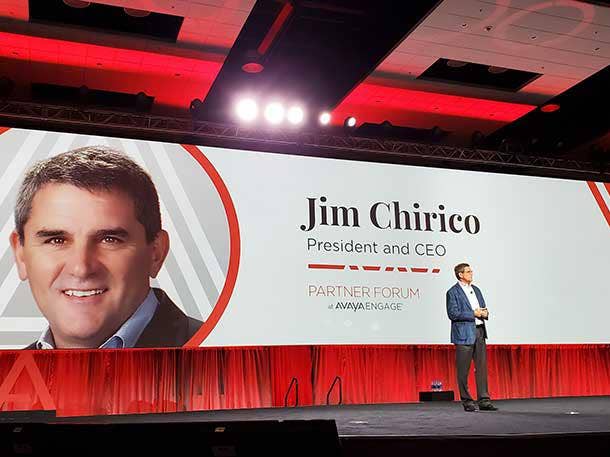Avaya CEO Jim Chirico: Partners Leading Charge On 'Record-High' Subscriptions Sales
The UC giant is earning record-high software, services, and subscriptions revenues, all of which are being driven by Avaya's channel partners, CEO Jim Chirico tells CRN.

Avaya was once an equipment-focused provider, but today the unified communications powerhouse is pulling in record-high software, services, and subscriptions revenues which shot up this quarter due in part to the COVID-19 coronavirus pandemic.
"I would say about 75 percent of our subscription revenue has been partner-led and that's exciting because it’s a transformation, not just from a technology perspective, but also a go-to-market perspective," Avaya CEO Jim Chirico told CRN following the company's Q2 2020 earnings call.
While Avaya was admittedly late to the cloud game, the once premises-based UC giant has spent the last three years focusing on software, cloud, and subscription-based solutions — a transformation that Chirico called "irreversible.”
[Related: Avaya Channel Chief: Shift To Cloud, Subscriptions Isn't A 'March Or Die' Message To Partners]
Avaya earned 88 percent of its overall revenue through software and services in Q2 2020, an uptick compared to 83 percent during the company's 2019 fiscal year. Chirico said that the company has seen a "steady climb" in these revenues as it pivots its focus to software and services.
Avaya told CRN in February that it would be relying on channel partners to help it make its transformation a success. Avaya does about 80 percent of its business though the channel today. The company's revenue during the most recent quarter consisted of 64 percent recurring revenue, another record-high for Avaya, which was primarily driven by partners, Chirico said.
“We expect recurring revenue to continue to grow,” he said. “The company has been historically handcuffed a little bit based on seasonality, but with 64 percent recurring revenue, we're much more predictable and not dependent on 1x sales, which will bode well for us for the foreseeable future.”
Avaya launched a subscription model in December and subscription revenue grew about 200 percent quarter-over-quarter as customers around the globe move to a subscription-based model for their technology consumption. Chirico said Avaya's goal is to move about 25 percent of its existing maintenance-oriented contracts to a subscription-based contract.
Partners are leading the subscription charge, Chirico said. “Many of partners have made a lot on maintenance, but they see the value of subscriptions. We're really leveraging the partner community quite a bit.”
The COVID-19 pandemic has driven home the importance of communication and collaboration technology, as well as the need for modernization of existing investments and infrastructure, Chirico said during the company's Q2 2020 earnings call on Monday. Avaya is already seeing strong, channel-driven sales for its RingCentral-powered UC offering, Avaya Cloud Office by RingCentral, which was launched in March. The company is also pushing its cloud-based videoconferencing solution, Avaya Spaces. Spaces' video and collaboration usage grew more than 2,000 percent in Q2 2020 and Avaya delivered close to 400,000 new licenses during the quarter as businesses moved their employees to work from home, the company said.
"[COVID-19] has pushed a new dynamic for us on our technology and innovation," Chirico said. "These new solutions are taking hold and I think they are the future of communications moving forward for sure," he said. "The macro environment, as unfortunate as it is right now, we're just glad we can participate in our small part and help our customers."
The pandemic has also proven that premise-based solutions are not dead at the enterprise level, Chirico said. "That's where most of the two million remote agent licenses went in the large enterprises this quarter, which is really in-line with our strategy," he said. "Premise, to hybrid, to eventually, public cloud, that's where subscription is really allowing us to provide an OPEX model yet still provide innovation into our install base."
Avaya's hardware business declined in Q2 2020, in part due to minor supply chain disruptions and larger impacts overseas, Chirico said.
Avaya said it has more than 100,000 global customers and more than 90 percent of the world's Fortune 100 businesses as customers.
The Santa Clara, Calif.-based company during its Q2 fiscal quarter said it extended 90 days of free access to Avaya Spaces to its employees and contractors to help them stay connected during the pandemic. The firm also announced Homework Connection, an initiative for U.S.-based Avaya employees that includes five free hours of homework help per month with a professional tutor to assist students learning from home.
Chirico said that Avaya, with the help of its partners, spent the fiscal quarter helping state and local government customers move to a work from home environment. The company's work with education institutions and healthcare facilities have also all been partner-led, he added.
For Q2 2020, which ended March 31, Avaya Holdings Corp.'s overall revenue slipped 4.5 percent year over year to $682 million, but it beat Wall Street's estimate of $624 million. In light of the uncertainties in the global business environment arising from the effects of COVID-19, Avaya withdrew its annual guidance for the rest of its 2020 fiscal year.